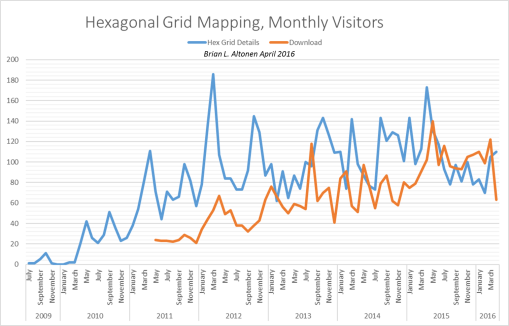Posted by Brian Altonen, MPH, MS under Uncategorized
Comments Off on Most Popular Pages
My top pages in recent months are as follows.

The large response to posting the Texas Cattle Drives page a few years ago has leveled out to the amounts displayed in the graph. Review of my page on the Oregon Trail thesis, demonstrating how to use mapping to investigate a historical outbreak, is my second most popular page. (There is also a blog site with the thesis and sections of work not included in the thesis for review.)

I am most interested in the hexagonal grid mapping site and its download page for the excel file I used to produce my first hex grid maps. This methodology is perhaps the most important addition to medical GISing techniques that I decided to undertake around winter of 2004, a technique which has not been fully appreciated as of yet. My argument for its value focuses primarily on the use of this method to reduce errors in data mapping and analyses.
I am due to develop the hex grid algorithms in several other formats for people to incorporate into their repertoire. I have to develop the SAS and perhaps SQL formulas for it. These will be employed within the next year to evaluate urban density patterns for medical research.
Posted by Brian Altonen, MPH, MS under Uncategorized
Comments Off on Managed Care and Medical GIS Surveillance, 2016

At What Level is Your Managed Care Program GIS-Savvy and Literate?-
For a couple of years I have been pointing out where the managed care profession lies in terms of its skillset when analyzing population health.
Most managed care companies left nearly half their potential behind when they ignored the advancements in GIS that developed over the past ten years. These changes in computer hardware and software, information technology, electronic medical records, data warehouse development, exceptionally large storage areas for long term medical records, made it possible for the research of 10 to 15 years of medical data to suddenly be accomplished by individuals like myself. With the right expertise in data mining and aggregation, the goal of producing GIS applicable findings is now possible. In a single day, several dozen diagnoses, research questions, spatial analyses can be performed at a moment’s notice. This past week along, I averaged more than 100 analyses per day using some of the most gratifying algorithms I developed for risk prediction and defining individual patient health, healthcare related needs.
It is important to note that insurance companies initiated the idea of mapping health, back in the 1860s and early 1870s. They stopped utilizing this means for evaluating health when the bacteria theory erupted, diverting the attention of many epidemiologists from the environmental setting, to the home setting and environment immediately next to the patient’s body, school, playground, party sites, meeting rooms, and workplaces.
The image at top depicts the status we are at in managed care when it comes to GIS utilization. It depicts the common behaviors seen in the managed care field, the level of accomplishment healthcare programs have reached when it comes to reaching their marketing and business potentials.

On a scale of 1 to 10, I place our system at 5.5, almost 6. That is to say we focus on retrospective analyses and information production and display for the most part. We rarely use spatial modeling to make predictions about our programs, its financial growth, its patient population, the local community health-related changes. We do not utilize grid mapping techniques, nor prediction modeling, nor quarterly spatial display of our services and finances, nor economic and quality of service assessment programs to score and improve our projects.
To many, taking the chance that well over half of them may have little impact or fail remains a major deterrent. Knowing the field your are in, and where and how to start such an exploratory process, is also a skillset lacking in upper level management.

But the advantage to employing an aggressive spatial surveillance and prevention-minded medical GIS is seeing the impacts of those few successes financially and healthwise. Chances are, if you evaluate 50 to 300 features of population health, design your surveillance system such that it allows you to engage in well targeted intervention programs, you make it possible for good news stories to be generated for your program by the end of each and every year.

The following are potential uses for medical GIS-HIT, which is why I keep the score for where managed care unexcitably low, and why the level of potential growth this business experienced at embarassing levels.

All of the others professions in healthcare have developed more rapidly and completely that managed care, regarding the use of EMR data. While programs still struggle to get their EMRs working, experts in GIS working in managed care are taking their data and doing hundreds of times more analyses and reporting, than simple meaningful use report writing can achieve.

For much more, see nationalpopulationhealthgrid.com









